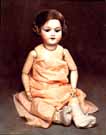
|
|
|

|

|

|

|
|
Click on an image to see a larger, more detailed picture.
|
|
|
|
|
| 1943: Death and Resistance |

|
pg. 438 |

|
|
|
|
| |
 Three elderly Jews walk arm-in-arm through the streets of Kraków, Poland, during the final liquidation of the ghetto. The deportations during 1942 had significantly reduced the number of ghetto inhabitants in Kraków and served as a prelude to the final liquidation that occurred in March 1943. That month 2000 Jews were transferred to the nearby Plaszów work camp, and 2300 more were deported to Auschwitz. Jewish Resistance groups helped hundreds of Kraków Jews escape to relative safety. Armed partisan groups were active in areas surrounding the city, and they engaged German troops in gun battles that helped indirectly to slow the pace of deportations.
Three elderly Jews walk arm-in-arm through the streets of Kraków, Poland, during the final liquidation of the ghetto. The deportations during 1942 had significantly reduced the number of ghetto inhabitants in Kraków and served as a prelude to the final liquidation that occurred in March 1943. That month 2000 Jews were transferred to the nearby Plaszów work camp, and 2300 more were deported to Auschwitz. Jewish Resistance groups helped hundreds of Kraków Jews escape to relative safety. Armed partisan groups were active in areas surrounding the city, and they engaged German troops in gun battles that helped indirectly to slow the pace of deportations.
Photo: Main Commission for the Investigation of Nazi War Crimes / United States Holocaust Memorial Museum Photo Archive
|
 The abandoned possessions of Jews recently deported from Kraków litter the streets of the ghetto. The liquidation of Kraków was a painfully brutal operation. In addition to the Jews who were deported to Plaszów, Poland, and Auschwitz, 700 Jews were shot on the spot.
The abandoned possessions of Jews recently deported from Kraków litter the streets of the ghetto. The liquidation of Kraków was a painfully brutal operation. In addition to the Jews who were deported to Plaszów, Poland, and Auschwitz, 700 Jews were shot on the spot.
Photo: Main Commission for the Investigation of Nazi War Crimes / United States Holocaust Memorial Museum Photo Archive
|
 This doll belonged to a child living in the Kraków (Poland) Ghetto. The doll's owner, Zofia Burowska, recovered it after the war from non-Jews who saved it for her. It was especially important to Zofia because it had been made specifically for her. Toys such as this doll were often the only links Jewish children had to a normal childhood.
This doll belonged to a child living in the Kraków (Poland) Ghetto. The doll's owner, Zofia Burowska, recovered it after the war from non-Jews who saved it for her. It was especially important to Zofia because it had been made specifically for her. Toys such as this doll were often the only links Jewish children had to a normal childhood.
Photo: Zofia Burowska / United States Holocaust Memorial Museum Photo Archive
|
|

|

|

|

|
 March 20, 1943: At Czestochowa, Poland, on the eve of Purim, more than 100 Jewish physicians, engineers, and lawyers as well as their families are taken to a cemetery by Nazis and shot. Victims include 56-year-old gynecologist Dr. Kruza Gruenwald, 30-year-old general practitioner Dr. Irena Horowicz, and 44-year-old neurologist Dr. Bernhard Epstein.
March 20, 1943: At Czestochowa, Poland, on the eve of Purim, more than 100 Jewish physicians, engineers, and lawyers as well as their families are taken to a cemetery by Nazis and shot. Victims include 56-year-old gynecologist Dr. Kruza Gruenwald, 30-year-old general practitioner Dr. Irena Horowicz, and 44-year-old neurologist Dr. Bernhard Epstein.
|
 March 21, 1943: During the Jewish festival of Purim, 2300 Jews from Skopje, Yugoslavia, are deported to Auschwitz.
March 21, 1943: During the Jewish festival of Purim, 2300 Jews from Skopje, Yugoslavia, are deported to Auschwitz.
|
 March 21, 1943: Eight members of the Jewish intelligentsia are taken from Piotrków, Poland, to a Jewish cemetery and shot, along with the cemetery's caretaker and his wife. The Germans engineer these killings to total ten, in a macabre reference to the biblical story of the hanged ten sons of the Jew-hating Haman--a crucial character in the Purim story.
March 21, 1943: Eight members of the Jewish intelligentsia are taken from Piotrków, Poland, to a Jewish cemetery and shot, along with the cemetery's caretaker and his wife. The Germans engineer these killings to total ten, in a macabre reference to the biblical story of the hanged ten sons of the Jew-hating Haman--a crucial character in the Purim story.
|
|
|
|
|
| 1943: Death and Resistance |

|
pg. 438 |

|
|
The Holocaust Chronicle
© 2009 Publications International, Ltd.
|
|
